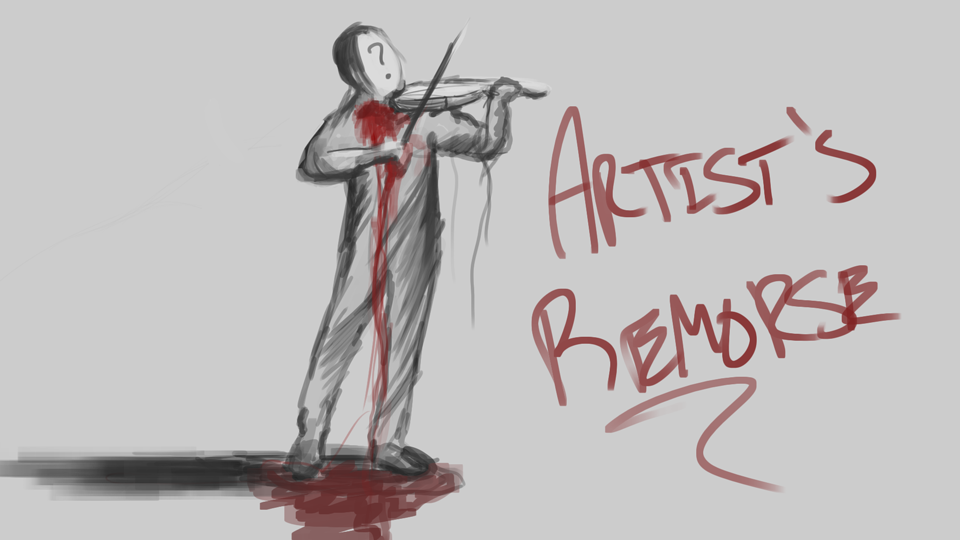Level Design [Word Doc]
The numbers coorelate with the list of items in the word file linked in the article we were assigned to read on worldofleveldesign.com.
Artistic Game Development I – Level Concept and Story
- Single Player
- Survival, Puzzle
- ADG I Level Design
Story:
- An artist performs his own coup de grace after a run in with depression. The real world had pressured him from every direction, leaving him to lock himself in his studio. In his last month, he created his final work, a projection of his internal struggles. Branching from his easel, the studio’s walls are stained with dark images, suggesting a more maniacal outlook on the world surrounding him.
Detective Clark enters the room to begin investigating the suicide of Mr. Opus. Curiously, a gust of wind closes the door behind him. A quick check of the door confirms the detective’s suspicion. Locked. With an attempt to force the door open, the abrasive sound of a violin’s twang cuts the silence.
- Turning around, Clark flicks his flashlight on, as he reaches for the light switch. A flash of light and the bulb blows just as quickly. Stepping slowly into the room, the player is soon introduced control of Clark. And it becomes the player’s goal to experience the haunting of Mr. Opus while discovering what led him to slice his own throat. Hidden in his drawings are the answers. Meanwhile, Mr. Opus continues to play the violin for the detective.
- The drawings stretched across the room direct the player’s investigation and Mr. Opus has somehow set up some dead ends. His mind even became a puzzle to himself, so unlocking the truth of his death becomes ever more confusing as the player tries to put the pieces together. Only when solving the puzzle does Mr. Opus’s music stop and the door opens.
Gameplay:
- The objective of the level is to discover the reason(s) for Mr. Opus’s suicide.
- From above, much of the information will be lost, as the drawings are cast along the walls, along with the answers to guide the detective out of the artist’s studio. It is for that reason that most concept art will be shown from the player’s first person perspective.
- The entirety of the level is one puzzle. Actually departing from the room may become second to the player’s priorities as he/she is lost in Mr. Opus’s story.
- Because this is a study of artistic design, much of the gameplay elements will be lost without the slightest bit of programming. That being said, the level will be staged up until the player believes to have solved the puzzle of the suicide. In the end, it is the interaction with the artistic surroundings that becomes the core gameplay.
- I want to give the player the chance to examine the room and Mr. Opus’s drawings for around a half hour. With the inclusion of red herrings, the player could be lost for longer.
- The level is not big, but will include a vast amount of information, including Mr. Opus’s life before the depression set in, along with what led him to his last month of cruel living.
- My audience is the crowd that is prepared for less of a game and more of an interactive story.
- Mr. Opus’s studio will be remembered as an unsettling invasion of another man’s life. The player will instantly feel as if he/she has imposed upon the darkest trenches of depression and death.
Visuals:
16/17. I am mostly inspired by the serial killer’s home in the show True Detective. The room’s unsettling displays of death, bloodlust, and depression will feel claustrophobic, as the player is constantly looking to each wall for answers. Everything begins to close in on itself.
19. At first, with the introduction of Mr. Opus’s ghost in the room, a suspenseful atmosphere is cast on the studio. As time passes though, the player will realize that the ghost is not a threat, but trapped in his own pit of despair, walls crawling with images of confusion and a lost mind.
20. Exploration will reward the player with more information about Mr. Opus’s story.
21. Though the drawings will feel so disconnected from each other, the player will discover that there is harmony in a number of them. All of the images will have something to say about Mr. Opus before and after the depression/suicide, as well.
22. I want to concentrate on artistic storytelling by creating a fulfilling atmosphere.
